
|

|

|
British and European Car Spotters Guide - 1949 |
|
|
 |
|
|
|
The British Motor Industry Recovers
By 1949 practically all British production cars were of new post-war design and most of them had been drastically redesigned or at least restyled. All were shown at the first post-war Earls Court Motor Show in London in late 1948, which needless to say, drew record crowds. Production during 1949 soared to an all-time high of 412,920 cars and 216,373 commercial vehicles, representing weekly averages of 7929 and 4161 respectively. Of the new cars 257,250 were exported, valued at just over £72½ million.
1868 cars were imported, worth just over half a million pounds. New car registrations for the UK domestic market were up by almost 40 per cent. Of the 1949 cars the Editor of 'The Motor' wrote: 'At last our new cars are ready ... In the most competitive markets in the world Britain can now claim the fastest, the finest, and the best finished automobiles available to the motoring public. In the vital matters of economy of operation, road holding, acceleration and braking, we can collectively or individually more than hold our own'.
The 1949 Scottish Motor Show - November 11th to 19th
by "Midlothian"
originally published in the November British Motor Industry Journal
Almost too quickly after Earl's Court we are in the busy whirl of our own Kelvin Hall exhibition, more important than ever this year because it houses a commercial vehicle section, thus making it thoroughly representative of the entire British motor industry. If anticipatory interest means anything, the organisers, the Scottish Motor Trade Association, will obtain a greater attendance than ever for this is the first time since 1938 that such an exhibition has been staged. Most of our own models are represented, but there is a lack of Continental and American vehicles. However, it is the industrial vehicle section that should attract most attention.
Here it may not be inappropriate to accuse the S.M.T.A. of lacking an appropriate news sense of the publicity value of their exhibition. To distribute drab, uninteresting posters of a colourless Highlander piping some hazy vehicles is not enough. An enterprising publicist would, I feel certain, have also had some literature regarding the show available somewhere at Earl's Court. Far be it from me to suggest how the S.M.T.A. should conduct their own affairs, but a greater helpfulness to the press is desirable, even necessary. It may be recalled that there was some momentary hesitation at the beginning of this year as to whether the show would really be held at all, but once a unanimous decision had been made, motor traders throughout Scotland lent their enthusiastic backing. The feeling was, of course, that this being a retailers' show there would be extreme difficulty in obtaining exhibition models.
Background Story of Show
For the generation that has arisen since the last Scottish Exhibition it may make a tour of the hall more interesting if they learn something of the story behind this mass display of transport vehicles. James MacFarlane treats the subject very nicely in his newly-published The Very Early Days, and whether he likes it or not, he has become willy-nilly the historian of the Scottish motor industry. If you wish to probe deeply into the past, let Macfarlane be your guide. However, that is by the way.
To deal with the story of the Scottish Show it is necessary to return to the opening years of the present century when, in 1903, a number of motor traders met in Edinburgh to discuss the formation of a motor trade association in Scotland. The association was duly constituted and bore the somewhat ponderous title of" The Scottish Motor Manufacturers' and Traders' Association ". Three years later it became the now familiar Scottish Motor Trade Association, succinct and precise.
The first annual exhibition of cars and cycles took place in the capital in 1898, so that, paradoxically, when the S.M.T.A. was inaugurated its show was already five years of age! The Association gave its patronage to the exhibition between 1904-1907 and was successful in obtaining certain privileges for its members. Other bodies granting patronage about this time included the then Scottish Automobile Club, the Scottish Cyclists' Union, and the Cyclists' Touring Club. That the word " cyclist" predominated is understandable when it is realised that in Scotland during 1904 there were less than 4,000 cars registered.
By 1907, the S.M.T.A. had completed arrangements with the S.M.M. & T. and become proprietors of the Scottish Motor Show, and the exhibition which was held in the Waverley Market, Edinburgh, in January, 1908, was the first one organised by the S.M.T.A. but was, in actual fact, the eleventh in the annual series. A quick glance at the 1908 exhibition catalogue makes interesting reading. The exhibitors included many concerns, some of whose products are now world famous and can be seen at this present show. Reference need only be made to the Albion Motor Co., Alexanders of Edinburgh Ltd., Croall & Croall, John Croall & Sons, the Dunlop Rubber Co., Jas. Gibbon (Motors) Ltd., Humber Ltd., Lanchester Motor Co., Joseph Lucas Ltd., North British Rubber Co., Palmer Tyres, and James Thomson & Son, now, of course, Thomson & Brown Bros. Ltd.
It Packed up Every Night
That so many firms should still be flourishing after 40 or more years in the motor trade is not only a tribute to the efficiency and enterprise of the firms themselves, but also evidence of the growth and ever-increasing prosperity of the trade. Obviously the shows could not take place during the priod of the two wars, and there are accordingly blanks in the records for the years 1915-19 and 1939-48. Until the first break in continuity, the exhibitions had always been staged in the famous Waverley Market, Edinburgh. However, much confusion was caused to stand holders in the early days, because each night the floor area had to be cleared in readiness for the fruit market that took place in the early hours of the morning! When the market closed, then the unfortunate exhibitors moved in again!
It will be appreciated that it was with a sigh of relief that the first show after World War I found the vehicles housed in more commodious premises in the original Kelvin Hall. From 1920 until 1925, when fire destroyed the new venue, the annual Scottish Show continued and prospered. While the present Kelvin Hall was being constructed - that is, for a period of two years - the show took place in what was then the Industrial Hall in Annandale Street, Edinburgh. In spite of restricted space and one very bad week of fog the record of success continued, and when, in 1927, the show opened its doors in the new and immense Kelvin Hall, a fresh era of increased business for exhibitors was started. (Exports didn't matter so much in those days!) Admittedly the trade recession of the early thirties had its effect but to judge from the attendance figures public interest in cars and transport matters did not abate. In 1939, of course, despite the near-completion of all arrangements, the show was postponed, so that this is the first occasion since World War II that the show has been held.
Dealers Co-operate
For the younger members of the trade, both in England and Scotland, this brief synopsis may prove interesting. The present show has attracted no fewer than 289 exhibitors, although perhaps it is a sign of the times through which we are passing that one trader has withdrawn " in view of the difficulty of obtaining cars for exhibit ". For the great majority of Scots it is their first opportunity of studying at close quarters the various details that illustrate the advances made in design since the last show in 1938.
Large Ford Display
An outstanding feature is the cooperative stands of the Ford Scottish main dealers who have combined together and taken over a not inconsiderable floor area. Thus on stands 31, 32 and 34 we find displayed three 8 h.p. Anglias, three 10 h.p. Prefects and three 30 h.p. Pilot saloons. Little change is to be recorded in the mechanical specification, although externally there are some noticeable modifications. For example, the Prefect now appears with in-built headlamps set well above the road, and with a radiator grille strongly resembling the Pilot. A smarter frontal appearance also characterises the Anglia, of which the salient features include a four-cylinder side valve engine, three-speed synchromesh gearbox and enclosed propeller shaft, the body being a full fourseater with generous accommodation.
The exhibitors are Alexanders of Edinburgh Ltd. (Edinburgh); H. K. Brown (Motors) Ltd. (Kirkcaldy); Chapman of Inverness Ltd. (Inverness); Dalblair Motors Ltd. (Ayr); Dunlop Motor Co. Ltd. (Kilmarnock); Wm. Dunnel & Co. (Thurso); Elgin Central Garage Ltd. (Elgin); Thomas Fairgrieve & Sons Ltd. (Stow); Frew & Co. Ltd. (Perth); Gale & Barclay Ltd. (Glasgow); George & Jobling (Glasgow); D. R. Gordon Ltd. (Bathgate); J. A. Laid-law (Airdrie) Ltd. (Airdrie); George G. McDiarmid Ltd. (Barrhead); Jas. McHarrie (Stranraer) Ltd. (Stranraer); A. McKer-cher (Aberfeldy); Macknight (Motors) Ltd. (Dumfries); J. Martin (Kirkintilloch) Ltd. (Kirkintilloch); J. M. Millar Ltd. (Falkirk); Millar's Garage (Stirling) Ltd. (Stirling); Wm. Montgomery & Sons (Strachur); J. J. Nicholson (Hamilton); A Normand & Co. Ltd. (Dunfermline); Paisley Motor Co. Ltd. (Paisley); Duncan Ramsay & Son (Campbeltown); A. W. Taylor & Son (In-vergordon); E. Watkinson & Co. Ltd. (Dumbarton); and Wylies Ltd. (Glasgow).
A Jowett Group
Another group display is that of the Jowett Javelin stockists. With independent front suspension, flat four-cylinder o.h.v. engine, and unit construction of body and chassis, the Javelin first appeared early in 1948, since which time it has earned a reputation for economy and reliability. More noteworthy is the news that the possibilities of the Javelin power unit have been developed in collaboration with E.R.A. engineers to provide a sports chassis which is one of the outstanding attractions. Generally speaking, the specification approximates the standard type but has a special camshaft and is tuned for high performance. Gearbox ratios have been raised from the 4-86 to I of the standard to 41 which brings the other gears to 5 63, 8-91 and 14-62.
Then the two-stage propeller shaft is also modified having Hardy-Spicer centre and rear couplings with sliding spines. The wheelbase is shorter at 93 in. compared with the standard 102 in., but front and rear tracks remain at 51 in. and 49 in. respectively. Incidentally, the chassis price is £495. Dealers concerned in the Jowett Javelin display are J. J. Aitken & Co. Ltd. (Kirkcudbright); J. R. Alexander & Co. Ltd. (Edinburgh); Bathgate Motor Co. Ltd. (Bathgate); David Blane & Son (Paisley); Dovemount Motors Ltd. (Hawick); Eastern Motor Co. Ltd. (Edinburgh); Holbarn Motors Ltd. (Aberdeen); Inverness Motor Co. Ltd. (Inverness); John McBain & Son Ltd. (Chirnside); P. S. Nicholson (Forres) Ltd. (Forres); Wm. Robb (Kirkcaldy); Stobcross Motor Co. Ltd. (Glasgow); Shields Motor Co. Ltd. (Perth).
Other Main Groups
Messrs. Wm. Cheyne of Aberdeen, C. C. Crowther Ltd. of Glasgow, and Gray Bros. (Dundee) Ltd., of Dundee, have grouped together on Stand 14 which is devoted exclusively to Citroen models. While there are no major alterations in either the Light Fifteen or the 22-6 h.p. Six, it should be noted that the arrangement of the pedals is slightly different to afford a more natural travel and the clutch is now controlled by a rod instead of, as previously, by cable. Salient features of Citroen design include F.W.D., independent suspension by torsion bars and monocoque construction. Moir & Baxter Ltd. of Edinburgh and their associates, Carlaw (Cars) Ltd. of Glasgow, respectively on Stands 16 and 17, feature the main Austin models. The aristocrat of the range is, of course, the A135 Princess which combines luxury transport with smooth acceleration, good road holding at high speed, and is from all points of consideration a very desirable motor car.
Popular interest, however, will probably centre round the A90 Atlantic Convertible, of which a prototype established 63 stock car records, running for seven days and nights on the Indianapolis Speedway at an average speed of 70 54 m.p.h. This was all the more remarkable when it is known that this was the first occasion upon which any non-American car has ever taken U.S.A. stock car records, so that, in a sense, it was motoring history. A newcomer to Scotland is the 760 c.c. Renault, of which three saloon models are exhibited by one of the oldest traders in the country, H. & D. Cleland Ltd., of Edinburgh, established in 1885. The 7-5 h.p. power unit is rear mounted, driving forward through a three-speed gearbox to halfshafts enclosed in trunnion casings carrying the independently sprung rear wheels.
The front suspension is also independent, and, as at the rear, coil springs are employed. These exhibits should be closely studied as representing a very successful Continental approach to the problem of economical motoring. Daimler and Lanchester appropriately enough share Stand 22 and fittingly their exhibits are among the most luxurious in Kelvin Hall. The Daimler Straight Eight remains mechanically unaltered, with its 5,460 c.c. engine developing around 150 b.h.p. The 2^-litre model, always a good seller in Scotland, is well represented. Newly-designed coachwork distinguishes the Lanchester. While frontal styling remains as before, the former body is replaced by four-light coachwork of more handsome lines.
Aston Martin and Lagonda share the floor area of Stand 37, epitomising most that is best in sports car design. The power unit of the 2J-litre Lagonda is particularly potent, so much so in fact that it will create a high average over long distances without noticeably effecting its occupants. Humber's Stand (No. 44) splendidly illustrates the restraint of British designers in not permitting streamline trends to override practical issues in engineering development. For those to whom the Pullman is too ostentatious there is always the Super Snipe which is powered by a 4,086 c.c. side valve Six of 100 b.h.p. This car happily combines modern and traditional Humber features. The Hawk, possessed of a fine road performance, is a family car of many virtues.
On Stand 42 J. Gibbon (Motors) Ltd. show the much discussed and entirely new Rover " 75 " of which the makers say they retained the previous coachwork designs until they found a sound reason for making a distinct and revolutionary change, i.e., until it became necessary by reason of chassis and engine development. The new body is lower and wider, providing greater interior accommodation. Retained, of course, is the highly satisfactory Six engine with its overhead inlet, inclined exhaust valves and high turbulence head.
Melvin Motors Ltd. (Stand 30), James Ross & Sons (Stand 46) and Andersons (Newton Meams) Ltd. (Stand 45) have a popular display of Rootes Group products. Sectioned models are so seldom seen in Scotland that the " Ghost" Minx on Stand 46—the steel body shell has been cut and " Perspex " panels fitted to enable all parts of the interior to be seen; the engine and all mechanical parts are sectioned and driven electrically—attracts unusual interest. The new Mark IV Minx has had its cubic capacity increased from 1,184-5 to 1,265 c.c. Parking lights are now separate units from the headlamps, a water pump is incorporated, and the instrument panel has been re-fashioned.
Wolseley cars are exhibited by several traders, notably among them being the Eastern Motor Co. (Edinburgh), John Goodall & Co. Ltd. (Dunfermline), H. Prosser & Sons Ltd. (Glasgow), Wm. Gillespie & Son Ltd. (Paisley), McLay's Garage Ltd. (Kirkintilloch) and J. M. Sloan & Co. Ltd. (Edinburgh). Gearbox ratios have been modified on the Four/Fifty model in the light of experience to provide an improved performance on the lower gears, and the rear lighting equipment has been modified to suit the overseas buyer. The Six-Eighty retains its electrically-operated auxiliary starting carburetter device for easy starting from cold.
Many Nuffield Exhibits
Such is the popularity of the Nuffield products that they are to be seen throughout the length and breadth of the hall. Star attraction is the Morris Minor which seems properly to have fired the imagination of a too long car-starved public. Both the Minor and the Oxford are of chassis-less construction with rack and pinion steering and torsion bars to the independent front suspension. The T.C. Midget and the li-litre M.G. saloon specially interest the motoring enthusiast, both models having an exhilarating road performance. Riley cars come near to outnumbering any other marque in the exhibition, and, here again, there is little alteration to be recorded so far as mechanical matters are concerned. This applies to both the li-and 2i-litre models, which are identical except for engine capacity and wheelbase. Nuffield products can be inspected on Stands 12, 20, 25, 48, 50, 52, and 53.
The Latest Triumphs
Standard Vanguard and Triumph Mayflower models attract their plentiful quota of admirers, anxious to see at close hand the result of the motor industry's first excursion into rationalisation. Really new is the 1 T-litre Triumph Mayflower saloon in modern knife-edge styling and of medium overall dimensions. The four-cylinder unit of 1,247 c.c. develops 35 b.h.p. at 4,000 r.p.m. and has a maximum torque of 693 Ib./in. at 2,000 revolutions. The makers claim a top speed of 63 m.p.h. while petrol consumption is stated to be in the neighbourhood of 35 m.p.g. From a standstill, 50 m.p.h. can be attained in slightly over 50 seconds. Its bigger companion, the 2-litre model, has some new modifications, principal point of interest being that it now carries a new chassis with independent front coil suspension.
It is powered by the 2,088 c.c. Standard Vanguard engine, gearbox and back axle. However, the price remains unaltered at £775 plus P T. of £216 0s. 7d. So far as the Standard Vanguard is concerned the observant will notice that the latest sealing arrangements give the rear compartment passengers more leg and elbow room, that the gear shift is on the left of the steering column to conform to international requirements and that the facia board instruments have been regrouped. The full range of the Standard Motor Co.'s products can be seen among the exhibits of Sutherland Motors (Dumfries) Ltd., Wellington Motor Co. (Ayr) Ltd., Jordanhill Motors Ltd., Macharg, Rennie & Lindsay Ltd., Rossleigh Ltd., Hawick Motor Co., and Callander's Garages Ltd.
Vauxhalls in Scotland
Through the vast dealer organisation of S.M.T. Sales & Service Ltd., the two Vaux-hall models have achieved great popularity in Scotland and their representation throughout the show is considerable. Wm. Hamilton (Motors) Ltd. show a Velox and a Wyvern, as do Hunter's Garage, while on the S.M.T.'s own Stand (No. 56) there is a sectioned working model of the Velox. Incidentally, the 1950 Vauxhalls remain basically unchanged, and lightness and accuracy of steering is enhanced by the use of a Burman box with worm and peg follower mounted on ball bearings, and by using a single steel ball at the base of the kingpin to support the weight of the car.
Cars with Individuality
In traditional manner the Clyde Automobile Co. Ltd., of Glasgow, and John Croall & Sons, of Edinburgh, feature Rolls-Royce and Bentley chassis with special coacnwork by such craftsmen as H. J. Mulliner, Park Ward & Co. Ltd., and Hooper & Co. (Coachbuilders) Ltd. The old-established Edinburgh concern have on view also a Singer Nine Roadster and one of the latest SMI500 four-door six-light saloons, tastefully finished in what the exhibitors are pleased to term " Cotswold Beige ", with upholstery to match. On Stand 38 Messrs. T. M. Gilroy show one A.C. saloon with bodywork by Buck-land and also a very striking sports tourer. It seems unnecessary to add that the A.C. makes its appeal because of the refreshing individuality in its design as well as in its performance.
Of the various Allard models on show, probably that which has greatest appeal to the sporting fraternity is the " J " type competition two-seater. With a cubic capacity of over four litres and developing 120 b.h.p. at 3,800 r.p.m., the V-8 engine, with an 8 to 1 compression ratio, has a performance traditionally Allard. It is featured by Frew's of Perth, Alexander's of Edinburgh Ltd., and George & Jobling, of Glasgow. In conjunction with their associate firm, James H. Gait Ltd., James M. Inglis Automobiles Ltd., are showing on Stand 40 an Alvis Fourteen special sports tourer and a saloon from the same factory. Included also are the two Bristol models which were shown at Earl's Court and it is a matter of comment that this is the first time a Bristol has appeared at a S.M.T.A. exhibition.
Taggarts (Glasgow) Ltd., J. Tweedie Ltd., and Croall & Croall, attract attention, among other items, to the newest Armstrong Siddeleys which have been increased in engine size and power, while wet cylinder liners are employed. Particularly interesting is the new Whitley four-door four-light saloon of semi knife-edge styling. Such is a survey of what is to be seen at Kelvin Hall, and perhaps it is a matter of regret that some well-known makers are missing and, of course, the products of U.S.A. and most Continental countries are conspicuous by their absence. |
 |
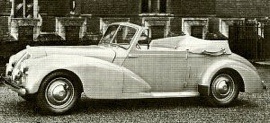 |
 |
AC 2-liter Drophead Coupe |
| |
Also see: AC Car Reviews | The History of AC (AUS Edition) |
| |
The AC 2-liter Drophead Coupe was introduced in March 1949, and was in production for only a very short period. It was discontinued in 1950 after only about twenty had been made, most of which went for export. AC's principal product was the two-door Saloon. |
|
 |
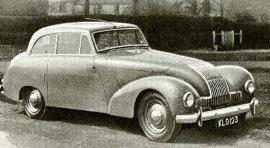 |
 |
Allard P1 Two-Door Saloon |
| |
Also see: Allard Car Reviews | The History of Allard |
| |
The Allard P1 two-door Saloon first appeared in 1949 and was continued until 1953. It was basically similar to the open cars which had been in production since 1946. powered by Ford V8 engines and using many other Ford components. The P1 had an aluminum panelled coachbuilt body and sold at £1277. |
|
 |
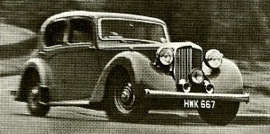 |
 |
Alvis Fourteen Model TA14 Saloon |
| |
Also see: Alvis Car Reviews | The History of Alvis |
| |
The Alvis Fourteen, Model TA14, was offered in chassis, Saloon and Drophead Coupe form. The latter was discontinued in September 1949, the Saloon in October of the following year. |
|
 |
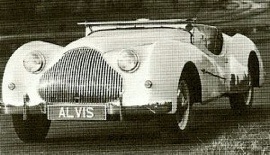 |
 |
Alvis Fourteen Model TB14 Special Sports Tourer |
| |
Also see: Alvis Car Reviews | The History of Alvis |
| |
The Alvis Fourteen, Model TB14, Special Sports Tourer was introduced in October 1948. The bodywork was reportedly designed in Belgium and not surprisingly was frowned upon by traditional Alvis customers. Underneath was a 9 ft wheelbase modified Fourteen chassis with a twin-carburetor 68-bhp variant of the standard 1892cc OHV Four engine. |
|
 |
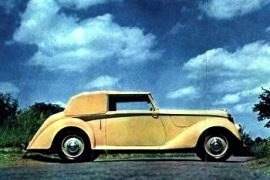 |
 |
Armstrong Siddeley Hurricane |
| |
Also see: The History of Armstrong Siddeley |
| |
The Armstrong Siddeley Hurricane was a two door, four seat drophead coupé automobile made by the British company of Armstrong Siddeley. It was made from 1946 to 1953 and based on the 1945 Armstrong Siddeley Lancaster. The chassis featured independent front suspension using torsion bars and a live rear axle with leaf springs. A Girling hydro-mechanical braking system was fitted, with the front drums hydraulically operated while those at the rear used rod and cable. Early models of the Hurricane were was fitted with a 70 bhp 1991cc six cylinder, overhead valve engine, carried over from the pre-war 16hp model but from 1949 this was enlarged to a 75 bhp 2309cc by increasing the cylinder bore from 65 to 70 mm. There was a choice of four speed synchromesh or pre-selector gearbox. The four seat, two door body was made of steel and aluminum panel fitted over a wood and aluminum frame. The doors were rear hinged, an arrangement that got the name of suicide doors. Changes during the model life were minimal: however, the bonnet line was slightly lowered for 1948 when the car also acquired stoneguards on the leading edges of its rear wings. At launch, the car cost £1151 on the UK market. |
|
 |
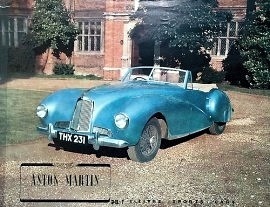 |
 |
Aston Martin 2-liter Sports DB1 |
| |
Also see: Aston Martin Car Reviews | The History of Aston Martin |
| |
The Aston Martin 2-liter Sports of 1948/49 became known as the OB1 with the advent of the OB2. Front suspension was independent with trailing arms, coil springs and anti-roll torsion bar. The rear axle was rigid, with coil springs, the torque being taken by arms extending from the axle to a cross member of the square-section fabricated steel tube frame. |
|
 |
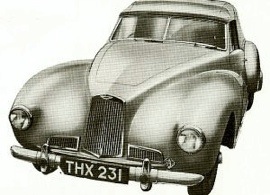 |
 |
Aston Martin 2-liter Sports DB1 |
| |
Also see: Aston Martin Car Reviews | Le Mans 1949 / Le Mans 1950 |
| |
The Aston Martin DB2 prototype, which was third at Spa in 1949 and raced at Le Mans in 1949 and 1950. This car was a development of Claude Hill's tubular space frame chassis with Tickford two-seater coupe bodywork. It was fitted with the 2·6-liter engine designed by W. O. Bentley for Lagonda (which, like Aston Martin and Tickford, was acquired by David Brown). |
|
 |
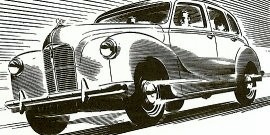 |
|
 |
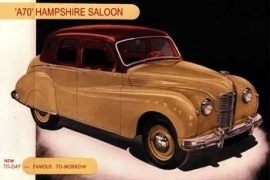 |
 |
Austin A70 Hampshire Saloon Model BS2 |
| |
Also see: Austin Car Reviews | The History of Austin (AUS Edition) |
| |
The Austin A70 Hampshire Saloon Model BS2 was introduced in July 1948. and had the same 2199cc engine as the old Sixteen (which was discontinued in March 1949). The Hampshire was produced until early 1951 and could be called a scaled-up edition of the A40 Devon. It featured independent front suspension and steering-column gearshift. Brakes were Girling hydraulic 2LS front, mechanical rear and wheelbase was 8 ft. From November an Estate Car version was offered, the Model BW3 Countryman.
|
|
 |
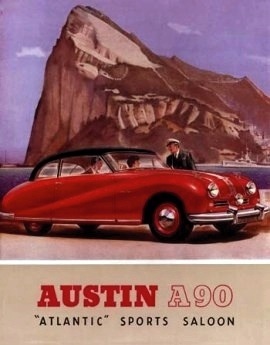 |
 |
Austin A90 Atlantic Convertible Model DB2 |
| |
Also see: Austin Car Reviews | The History of Austin (AUS Edition) |
| |
The Austin A90 Atlantic Convertible Model DB2, appeared in February 1949. It featured rather unusual body styling and was powered by a twin-carburetor (SU) 2660-cc OHV Four engine of 88 bhp (a larger-bore edition of the Sixteen and A70 engine). The Atlantic made history at Indianapolis, USA where it broke many international records during an impressive run which lasted seven days and nights.
|
|
 |
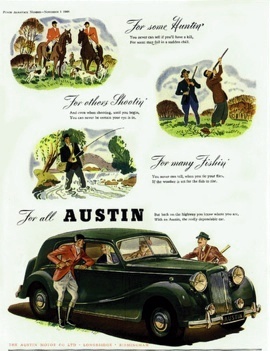 |
 |
Austin A125 Sheerline DS1 and A135 Princess DS2 |
| |
Also see: Austin Car Reviews | The History of Austin (AUS Edition) |
| |
The Austin A125 Sheerline DS1 and A135 Princess DS2 were carryovers from the previous year. In September 1949, an A125 Limousine was introduced. This car, designated Model DM1, was a lengthened six-light edition of the Saloon, with a wheelbase of 11 ft (v. 9 ft 11½ in). It had a glass partition between front and rear compartment and a two-piece propeller shaft. A Touring Limousine (DM2) version of the Vanden PIas bodied A135 Princess had been 46C Austin A90 Atlantic introduced in the previous October. |
|
 |
 |
 |
Austin A90 Atlantic |
| |
Also see: Austin Car Reviews | The History of Austin (AUS Edition) |
| |
Austin Hire Car, Model FL 1, was a four-door edition of the FX3 Taxi (1948-59) with single-piece front seat It had the 2·2-liter (2199cc) OHV Four engine, developing 67 bhp at 3800 rpm, driving through a four-speed gearbox and underslung worm drive rear axle. Brakes were Girling mechanical and four hand-operated Smith hydraulic jacks were standard fitments. Turning circle was 35 ft Later models had a hypoiddtype rear axle. |
|
 |
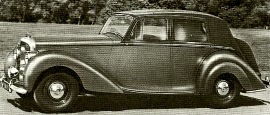 |
 |
Bentley 4 Door Sports Saloon |
| |
Also see: Bentley Car Reviews | The History of Bentley |
| |
Bentley models from September 1948 featured a narrow chromium waistline strip, curved rear wing valances (half-spats) and new type pleated upholstery. As usual, there was a selection of body styles to choose from, including several by well-known coachbuilders. Shown is the Four-door Sports Saloon as produced by the makers, Bentley Motors (1931) Ltd, themselves and costing £4038. It was generally known as the 'standard body'. |
|
 |
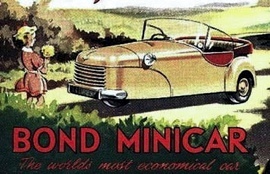 |
 |
Bond Minicar |
| |
Also see: Bond Car Reviews | The History of Bond (AUS Edition) |
| |
Bond Aircraft and Engineering Co (Blackpool) Ltd of Longridge, Lancashire, introduced their first three-wheeler in mid-1948. Intended as a 'runabout for shopping and calls within a 20-30 mile radius', the car had a chassisless body of stressed-skin construction. It was powered by a 125-cc Villiers two-stroke engine, mounted on a swivelling fork which carried the front wheel, suspension being by means of a trailing link. The brakes operated only on the unsprung but resiliently and independently mounted rear wheels. Shown is a prototype. Quantity production commenced in 1949 with the Mark A. |
|
 |
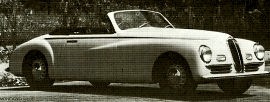 |
 |
Bristol 400 and 401 Saloon, 402 Convertible |
| |
Also see: Bristol Car Reviews | The History of Bristol (AUS Edition) |
| |
Bristol produced three types of cars, namely the 400, the 401 (five-seater Saloon, from September 1948) and the 402 (Convertible version of 401). The latter chassis was used also by some other coachbuilders, including Pinin Farina (later Pininfarina) of Turin, Italy. Shown is a Farina Cabriolet 2 posti. |
|
 |
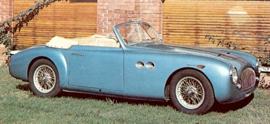 |
|
 |
 |
 |
Daimler 2½-liter 0818 Special Sports Coupe |
| |
Also see: Daimler Car Reviews | The History of Daimler (AUS Edition) |
| |
Daimler 2½-liter 0818 Special Sports Coupe, bodied by Barker, was made from October 1948 until 1953. It had a twin-carburetor OHV Six engine with light-alloy cylinder head, producing 85 bhp at 4200 rpm (v 70 bhp of the standard 2½-liter). Price was £2560. |
|
 |
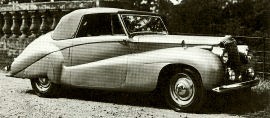 |
 |
Daimler Straight Eight Model DE36 Drophead Coupe |
| |
Also see: Daimler Car Reviews | The History of Daimler (AUS Edition) |
| |
Daimler Straight Eight Model DE36 chassis with Drophead Coupe bodywork by Hooper. This huge car, shown at the Earls Court Motor Show in October/November 1948, was finished in canary yellow and cost £7000. The 12ft 3 in wheelbase chassis sold at the basic price of £2025, the coachwork always being produced and fitted by specialist coachbuilders. |
|
 |
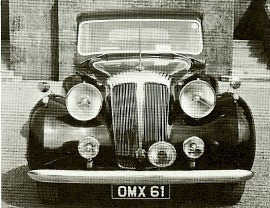 |
 |
Daimler Straight Eight Limousine |
| |
Also see: Daimler Car Reviews | The History of Daimler (AUS Edition) |
| |
Daimler Straight Eight with Limousine coachwork by Hooper. The engine was an OHV eight-cylinder in-line 5½-liter with two SU carburetors and an output of 150 bhp at 3600 rpm. It drove the hypoid rear axle through a fluid flywheel with preselector gearbox. Also available in chassis form only was the DE27, a six-cylinder variant with the same bore and stroke (85·1 x 120 mm) and shorter wheelbase (11 ft 6½ in). |
|
 |
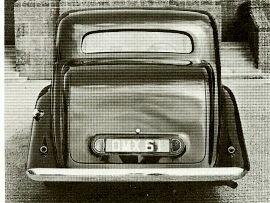 |
 |
Daimler Straight Eight Limousine |
| |
Also see: Daimler Car Reviews | The History of Daimler (AUS Edition) |
| |
Daimler Straight Eight with Limousine coachwork by Hooper. The engine was an OHV eight-cylinder in-line 5½-liter with two SU carburetors and an output of 150 bhp at 3600 rpm. It drove the hypoid rear axle through a fluid flywheel with preselector gearbox. Also available in chassis form only was the DE27, a six-cylinder variant with the same bore and stroke (85·1 x 120 mm) and shorter wheelbase (11 ft 6½ in). |
|
 |
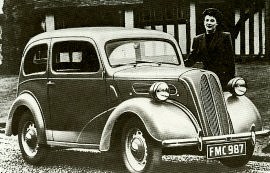 |
 |
Ford Anglia Model E494A |
| |
Also see: Ford UK Car Reviews | The History of Ford |
| |
Ford Anglia received a facelift in October 1948, and was re-designated Model E494A. The new radiator grille followed the same contour as that of the Eights and Tens of 1937-39, but now had two upright vertically-slatted openings. Introduced at the same time was an Anglia export version with the 1172-cc engine of the Prefect. This car differed in having a '10' radiator badge, the rear number plate mounted on the left and an extra tail lamp. The 1953-59 Ford Popular 103E was a direct descendant from this export-Anglia (which could be bought in the UK only for dollars i). The E494A standard Anglia retained the smaller-bore 933-cc engine. Both were long-stroke (92·5 mm) Fours. |
|
 |
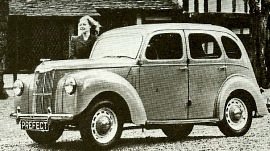 |
 |
Ford Prefect E493A |
| |
Also see: Ford UK Car Reviews | The History of Ford |
| |
Ford Prefect also had a restyled front end, but more so than the Anglia. The radiator grille of the Prefect. now designated E493A. was not unlike that of the larger Pilot but the headlamps were incorporated in the wings, which were also higher than before. In its new form, but retaining the old 1172-cc engine, it was made until 1953. |
|
 |
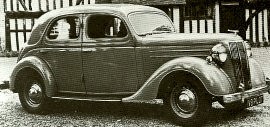 |
 |
Ford Pilot V8 Model E71A |
| |
Also see: Ford UK Car Reviews | The History of Ford |
| |
The Ford Pilot V8 Model E71A was continued with periodical modifications and improvements, rather than annual face-lifts. In March 1949, for example, the rear axle ratio was changed from 4·11 to 3·78: 1, and a bonnet safety catch was added. |
|
 |
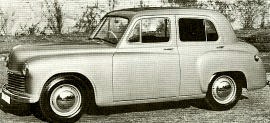 |
 |
Hillman Minx Mark III |
| |
Also see: Hillman Car Reviews | The History of Hillman (AUS Edition) |
| |
The Hillman Minx models were entirely restyled for the 1949 model year. The new Mark III models, introduced in September 1948, incorporated the most drastic changes in the long line of these popular family cars since 1936 (the original Minx dated back to 1931). The full-width bodywork was styled by Raymond Loewy, who was also responsible for the post-war Studebakers. The new car retained most of the existing mechanical components but had independent front suspension with coil springs Wheelbase was 7 ft 9 in. Price £505. |
|
 |
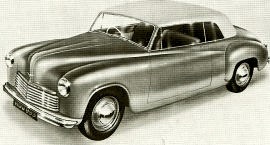 |
 |
Hillman Minx Mark III Drophead Coupe |
| |
Also see: Hillman Car Reviews | The History of Hillman (AUS Edition) |
| |
The Hillman Minx Mark III Drophead Coupe shared the 1949 restyling with the Saloon. Compared with the Mark II it now had rear quarter windows, which could be cranked down into the bodysides. The price was £576. |
|
 |
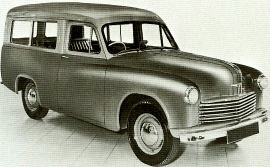 |
 |
Hillman Minx Mark III Estate |
| |
Also see: Hillman Car Reviews | The History of Hillman (AUS Edition) |
| |
The Hillman Minx Estate Car, as before, combined the styling of the Saloon and the Commer Supervan. The Estate Car sold at £595, the Van at £350. They had the same 1185-cc side-valve Four engine as the other Minxes. |
|
 |
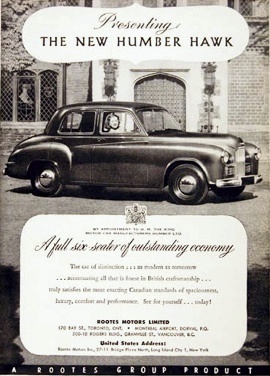 |
 |
Humber Hawk |
| |
Also see: Humber Car Reviews | The History of Humber |
| |
The Humber Hawk was completely restyled, along the same lines as Rootes' smaller Hillman Minx, the main difference being the vertical radiator grille. Unlike the Minx, the Hawk retained a separate chassis frame. The new model was designated Mark III and, again like the Hillman Minx, featured independent front suspension, but had the engine of the previous model, in this case the 1944-cc side-valve Four unit (which was also used in certain Rootes Commer and Karrier trucks). Wheelbase was 8 ft 9½ in, price £799. |
|
 |
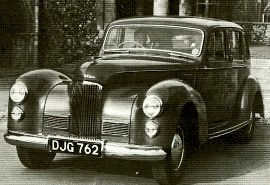 |
 |
Humber Super Snipe Mark II |
| |
Also see: Humber Car Reviews | The History of Humber |
| |
The Humber Super Snipe for 1949 (Mark II) was also restyled, but not as dramatically as the Hawk. It was now a full six-seater, with longer wheelbase. steering-column gearshift and other modifications. The engine was basically the same 4086-cc 100-bhp Six as before. The Snipe was discontinued. The Pullman became available in Saloon form, without partition and designated Imperial, and the Super Snipe Saloon was joined by a Touring Limousine variant. both in the autumn of 1949. |
|
 |
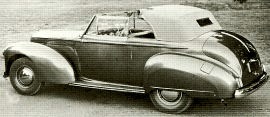 |
 |
Humber Super Snipe Mark II Drophead Coupe |
| |
Also see: Humber Car Reviews | The History of Humber |
| |
The Humber Super Snipe Drophead Coupe was produced in very small quantity by Tickford. The top was of the three-position type: fully open, half closed and fully closed. |
|
 |
 |
 |
Jaguar Mark V Saloon and Drophead Coupe |
| |
Also see: Jaguar Car Reviews | Jaguar - A Racing Pedigree |
| |
Jaguar Mark V models, Saloon and Drophead Coupe, were introoduced in October 1948. They were available with 2½ and 3½ liter engine. The 1½-liter model was discontinued in March 1949, and the old style 2½- and 3½- liter Saloons were kept in production until October. |
|
 |
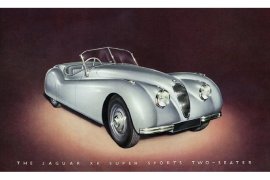 |
 |
|
| |
Also see: Jaguar Car Reviews | Jaguar - A Racing Pedigree |
| |
The Jaguar XK120 was a brand new and sensational Sports Two-Seater, and it hit the automotive world like a bombshell. It had a new twin-OHC 3½- liter 160-bhp six-cylinder engine, extremely fast and yet sufficiently docile for ordinary motoring. On a stretch of the Brussels-Ostend motorway near Jabbeke, an XK120 was officially timed at over 132 mph, the only non-standard fitment being an undershield. An American journal, Californian Autonews, wrote: 'it is typically British that Jaguar never claimed more than 120 mph for this car'. |
|
 |
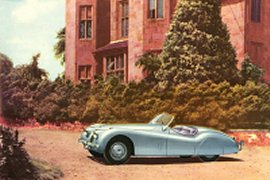 |
 |
|
| |
Also see: Jaguar Car Reviews | Jaguar - A Racing Pedigree |
| |
The Jaguar XK120 was uniquely and beautiifully styled. The car was originally intended for a limited production run, but the demand was so great particularly in the USA that it was kept in production until 1954 and then continued in XK140 and XK150 form until superseded by the E-type in 1961. |
|
 |
 |
 |
|
| |
Also see: Jaguar Car Reviews | Jaguar - A Racing Pedigree |
| |
Jaguar XK120s in standard and modified form took part in numerous sporting events. This picture shows the 1949 Silverstone race winner in full swing, hotly pursued by another XK and a Healey. In 1951 a special competition version appeared: the C-Type (XK120C), which was very successful at Le Mans. |
|
 |
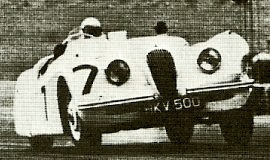 |
 |
|
| |
Also see: Jaguar Car Reviews and Le Mans 1951 |
| |
Jaguar XK120s in standard and modified form took part in numerous sporting events. This picture shows the 1949 Silverstone race winner in full swing, hotly pursued by another XK and a Healey. In 1951 a special competition version appeared: the C-Type (XK120C), which was very successful at Le Mans. |
|
 |
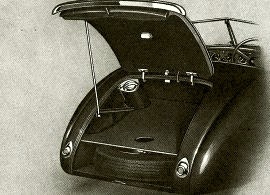 |
|
 |
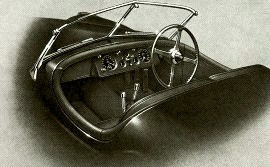 |
|
 |
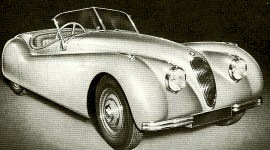 |
|
 |
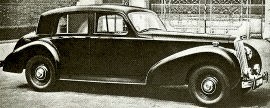 |
 |
Jensen 4-Door Saloon and Convertible |
| |
Also see: Jensen Car Reviews | The History of Jensen |
| |
Jensen Motors Ltd of West Bromwich, who before the war had built Ford V8-engined Specials, announced a new luxury car in 1946. Actual series production commenced in 1948, there being a four-door Saloon and a four-door Convertible. The eight-cylinder OHV engine, produced by Henry Meadows Ltd, had a capacity of 3860 cc and a maximum output of 130 bhp. In September 1949, this engine was replaced by the 4-liter Six of the Austin A125 Sheerline. |
|
 |
 |
 |
Jowett Javelin Series PA |
| |
Also see: Jowett Car Reviews | The History of Jowett |
| |
The Jowett Javelin Series PA was one of the first of British post-war car designs that kept selling well in both the UK domestic market and overseas. In September, the 1950 Series PB was announced in Standard and De Luxe form, with differences in trim and equipment. Javelins came 1st and 3rd in the 1949 Monte Carlo Rally (1½-liter class) and 1st in the Belgian 24-hour Grand Prix (2-liter touring class). |
|
 |
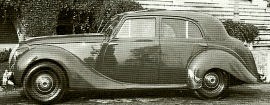 |
 |
Lagonda 2½-liter Mark I Saloon |
| |
Also see: The History of Lagonda |
| |
The Lagonda 2½-liter Mark I Saloon was continued from 1948 without change and produced until October 1952. The Mark I Drophead Coupe was continued until 1953. |
|
 |
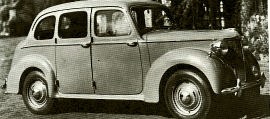 |
 |
Lanchester Ten, Series L010 |
| |
Also see: The History of Lanchester |
| |
The Lanchester Ten, Series L010, with all-steel saloon bodywork by Briggs, was conceived before the war and produced from 1946 until September 1949, when it was replaced by a four-light Barker-bodied (coachbuilt) saloon on the same 8 ft 3 in wheelbase chassis. This is the Briggs-bodied car. The Barker-bodied successor was made until mid-1951 . |
|
 |
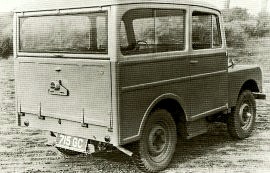 |
|
 |
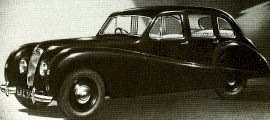 |
 |
Lea-Francis Fourteen |
| |
Also see: The History of Lea-Francis |
| |
The Lea-Francis Fourteen for 1949 had restyled six-light bodywork with the headlamps incorporated in the front end, and front wings flowing back to blend in with the rear wings. The 9 ft 3 in wheelbase chassis now had independent front suspension with torsion bars. There were two versions: the Mark V and Mark VI (shown), the latter being a luxurious edition with sliding roof, heater, radio, etc. Both were made primarily for export. |
|
 |
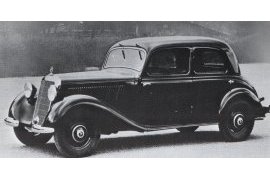 |
 |
Mercedes-Benz 170D |
| |
Also see: Mercedes-Benz Car Reviews | The History of Mercedes-Benz |
| |
As with its twin the 170S, the 170D was the first
serious production Mercedes saloon to appear after the
war. The 170D naturally shared its body with the 170S, but
with the implementation of a diesel motor the car was
able to offer the motoring public a much more economically
viable method of transport at a time when economic hardship
was rife. In fact, it was the experience gained in 1936 with the 2.6 liter diesel engined passenger cars that Mercedes had been manufacturing prior to the war that allowed the rapid development of a post-war diesel powered Mercedes. |
|
 |
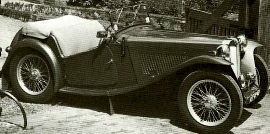 |
 |
MG Midget TC |
| |
Also see: MG Car Reviews | The MG Story | The History of MG |
| |
The MG Midget TC was now in its last year and for 1950 was modified in several respects such as the adoption of independent front suspension, rack and pinion steering (as on Y-type) and bolt-on disc wheels. Of the TC approximately 10,000 were built from late 1945 until December 1949. |
|
 |
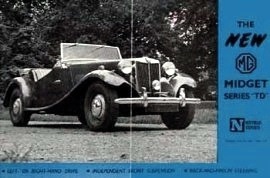 |
 |
MG TD |
| |
Also see: MG Car Reviews | The MG Story | The History of MG |
| |
Developed in 1949 for the 1950 model year, the MG TD combined the TC's drivetrain, a modified hypoid-geared rear axle, the MG Y-type chassis, a familiar T-type style body and independent suspension using coil springs from the MG Y-type saloon. Also new were rack and pinion steering, smaller 15-inch (380 mm) disc type road wheels, a left-hand drive option and standard equipment bumpers and over-riders. The car was also 5 inches (130 mm) wider with a track of 50 inches (1,300 mm). |
|
 |
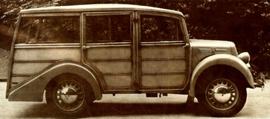 |
|
 |
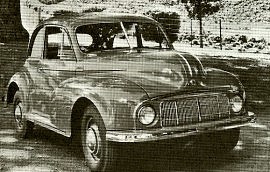 |
 |
Morris Minor |
| |
Also see: Morris Car Reviews | Morris Production Details 1939 - 1950 |
| |
Morris introduced their completely new post-war designs in October 1948, following many years of development. The development of the Minor, in fact, can be traced back to the war years when Mr (later Sir) Alec Issigonis first put its basic shape on paper. It was then code-named Mosquito and intended to have a flat-four engine. When it appeared as the Minor it was powered by the 918-cc Series E engine of the Eight which it replaced, but apart from this the car was a total departure from earlier Morris practice. |
|
 |
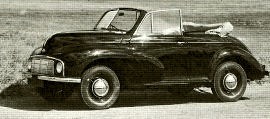 |
 |
Morris Minor Series MM |
| |
Also see: Morris Car Reviews | Morris Production Details 1939 - 1950 |
| |
The Morris Minor Series MM was available originally in two-door Saloon and Tourer variants. Later more body styles were added and, from June 1951, the Tourer was known as Convertible. The Minor had a 27·5-bhp side-valve Four engine with four-speed gearbox and 7 ft 2 in wheelbase. The front wheels were suspended independently, and steered by rack and pinion. Tyre size was 5.00-14 and price £383 for both models. |
|
 |
 |
 |
Morris Oxford Series MO |
| |
Also see: Morris Car Reviews | Morris Production Details 1939 - 1950 |
| |
The Morris Oxford Series MO was introduced simultaneously with the Minor and featured the same basic styling. It was available only as a four-door Saloon. at £546. Engine was a 1476·5-cc (73·5 x 87 mm) side-valve Four, developing 41 bhp at 4200 rpm. driving through a four-speed gearbox with column shift. Like the Minor, the car had independent front suspension with torsion bars and unitary body-cum-chassis construction. |
|
 |
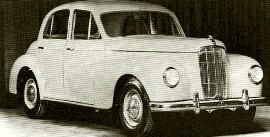 |
 |
Morris Six Series MS |
| |
Also see: Morris Car Reviews | Morris Production Details 1939 - 1950 |
| |
The Morris Six, Series MS, was the Company's third new car for 1949. Priced at £672, this model had the same bodyshell as the Oxford but a longer bonnet, accommodating a 65-bhp six-cylinder OHC engine, and a vertical radiator grille. Wheelbase of the Oxford and Six was 8 ft 1 in and 9 ft 2 in respectively. |
|
 |
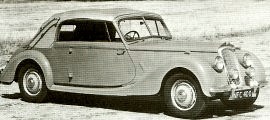 |
 |
Riley 2½-liter RMD Drophead Coupe |
| |
Also see: Riley Car Reviews | The History of Riley |
| |
The Riley 2½-liter RMD Drophead Coupe was produced from September 1948, until 1951. It cost £1215 and was based on the 2½-liter Saloon. In addition there were the three-seater Roadster at £1125 and the 1½-liter Saloon at £913. The Roadster had steering-column mounted gearshift until January 1950, when it became a two-seater with centrally mounted remote control lever, like the other models. |
|
 |
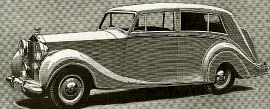 |
 |
RolIs-Royce Silver Wraith 4¼-liter Touring Limousine |
| |
Also see: Rolls-Royce Car Reviews | The History of Rolls-Royce |
| |
The RolIs-Royce Silver Wraith 4¼-liter Touring Limousine by Hooper, which cost £6068 and was the most expensive model in the 1949 catalogue. July saw the introduction of the smaller export-only Silver Dawn, which had the steel saloon body of the 'standard' Bentley. It was not until late in 1953 that the Silver Dawn became readily available on the home market, by which time it had undergone several detail modifications. |
|
 |
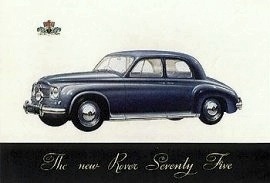 |
 |
Rover 75 Cyclops |
| |
Also see: Rover Car Reviews | The History of Rover (AUS Edition) |
| |
The Rover Seventy-Five was superseded in September by the P4 Series, which was entirely new with the main exception of the six-cylinder engine - in 1953 the Sixty was brought in line with the P4 Seventy-Five and another version, the P4 Ninety, added. |
|
 |
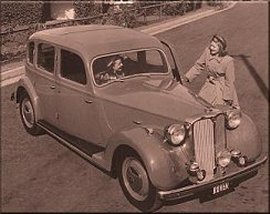 |
|
 |
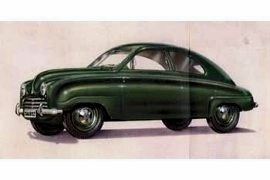 |
 |
Saab 92 |
| |
Also see: Saab Car Reviews | The History of SAAB |
| |
All early Saab 92s were painted in a dark green color similar to British racing green. According to some sources, Saab had a surplus of green paint from wartime production of airplanes. Saab's rally history already started two weeks after the 92 was released, when Saab's head engineer Rolf Mellde entered the Swedish Rally and came second in his class. |
|
 |
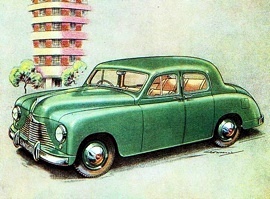 |
 |
Singer SM1500 Saloon |
| |
Also see: Singer Car Reviews | The History of Singer |
| |
The Singer SM1500 Saloon made its appearance in October 1948, and during 1949 the earlier Super Ten and Twelve Saloons were phased out. The SM1500 was placed into quantity production in mid-1949, alongside the Nine Roadster, and was an entirely new modernized model with coil-spring independent front suspension, full-width body on longer wheelbase (separate) chassis. The body styling was not as elegant as most of its contenders in the 1½-liter class. The price was £799. |
|
 |
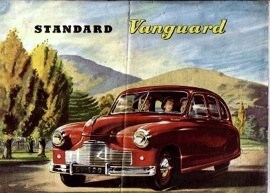 |
 |
Standard Vanguard Series 20S |
| |
Also see: Standard Car Reviews | The History of Standard |
| |
Standard continued their well-selling Vanguard Series 20S (later known as Vanguard Phase I) Saloon, which had now become available on the home market. Like most British 1949 models, the car featured separate side lights from September (1950 model year). Phase I models remained in production, with periodical modifications, until 1953 when the beetle-back body was restyled and given a 'notch-back' rear end with projecting boot. |
|
 |
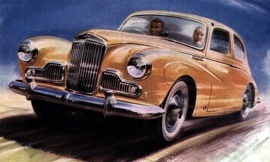 |
 |
Sunbeam-Talbot 80 and 90 |
| |
Also see: Sunbeam Car Reviews | The History of Sunbeam |
| |
The Sunbeam-Talbot Ten and 2-liter Saloons were superseded in the summer of 1948 by completely restyled models, the 80 and the 90, selling at £889 and £953 respectively. The very sleek bodywork, retaining the exclusive rear side window configuration, was by Thrupp & Maberly and was the same for both cars. The main differrence was in the engine size, which was 1185 and 1944 cc like the preceding Ten and 2-liter resp., but now with overhead valves and other modifications resulting in better performance, namely 47 bhp for the 80 and 64 for the 90. |
|
 |
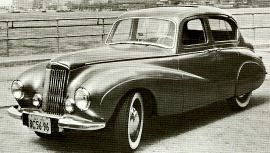 |
 |
Sunbeam-Talbot 80 and 90 |
| |
Also see: Sunbeam Car Reviews | The History of Sunbeam |
| |
The Sunbeam-Talbot 80 and 90 were availlable as two-door Convertible Coupe with three-position top. They cost £991 and £1055 respectively. |
|
 |
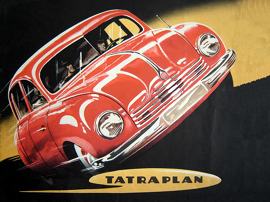 |
 |
Tatra Tatraplan 600 |
| |
Also see: Tatra Car Reviews | The History of Tatra |
| |
After World War 2 the Tatra works were nationalised in by the Czech government, and car production was concentrated on two types, the old front-engined 57B four-cylinder model and the rear-engined 87 eight-cylinder, though Tatra's main immediate post-war task was to replace the 60,000 railway waggons and carriages lost by Czechoslovakia. But the firm was still the country's biggest car and truck maker, accounting for 46 per cent of car production in 1946 and 1947 and employing over 5000 workers. A new passenger car was introduced in 1948 to replace the 57B and 87 - the Tatraplan T600, based on the pre-war 97 but with a two-liter engine mounted in the rear. Production of this car was transferred in 1951 from Koprivnice to the firm's AZNP Mlada Boleslav factory, in order to make way for the manufacture of T128 and T111 R trucks in quantity. (Production of railway rolling stock also ceased in the same year for the same reason.) |
|
 |
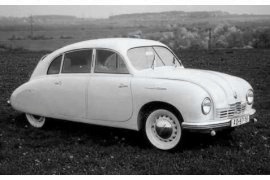 |
 |
Tatra Tatraplan 600 |
| |
Also see: Tatra Car Reviews | The History of Tatra |
| |
Years of production: 1949-1951-1953 (pre-series 1947 (Tatra 107))
4x2 rear-motor 4-door sedan
Engine: 52hp/4000rpm, aircooled 4-cyl. boxer OHV, 1952cc
Bore/Stroke: 85/86 mm
Compression ratio: 6 : 1
Length: 4,54m, width: 1,67m, height: 1,52m
Wheelbase: 2,70m
Front suspension: parallelogram with 2 transversal leaf springs
Rear suspension: independent, with 2 coil springs
Front- and rear wheeltrack - 1,300mm
Weight: 1200 kg
Mechanical brakes on all wheels
Maximal speed: 130 km/h
Fuel consumption: 11 L/100km
3 cars built with non-petrol but oil engines.
In 1951 production was moved from Koprivnice to Mlada Boleslav. |
|
 |
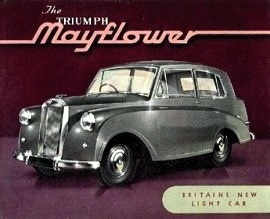 |
 |
Triumph Mayflower |
| |
Also see: Triumph Car Reviews | The History of Triumph |
| |
The Mayflower was the first small car to be built by Triumph under their new owners the Standard Motor Company and used a version of the pre-war Standard 10 side-valve engine updated by having an aluminum cylinder head and single Solex carburetor. The engine developed 38 bhp (28 kW) at 4200 rpm. The 3-speed gearbox, with column shift, came from the Standard Vanguard and had synchromesh on all the forward ratios. There was independent suspension at the front using coil springs but a solid back axle and half-elliptic leaf springs, also based on the one used on the Vanguard, was at the rear. The front-suspension design went on to be used on the Triumph TR2. Lockheed hydraulic brakes were fitted. A car tested by the British magazine The Motor in 1950 had a top speed of 62.9 mph (101.2 km/h) and could accelerate from 0–50 mph (80 km/h) in 26.6 seconds. A fuel consumption of 28.3 miles per imperial gallon (9.98 L/100 km; 23.6 mpg-US) was recorded. The test car cost £505 including taxes. In the same year the similarly sized but less well equipped and more aggressively priced Morris Minor was advertised at £382. |
|
 |
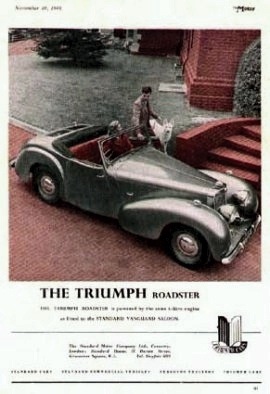 |
 |
Triumph Roadster 2000 |
| |
Also see: Triumph Car Reviews | The History of Triumph |
| |
The Triumph 2000 Roadster, Series 20TR, was in its last year. Compared with the preceding 1800 model, the 1949 model had the same engine as the Standard Vanguard and also the latter's three-speed gearbox, replacing the earlier four-speed type. In all, about 4500 Roadsters were made. Visible ahead of the boot lid handles is the hinged glass-panelled lid, which, when erected, formed a windscreen for the passengers in the dickey seat. |
|
 |
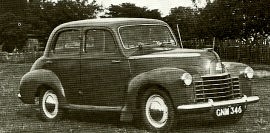 |
 |
Vauxhall Wyvern and Velox |
| |
Also see: Vauxhall Car Reviews |
| |
Vauxhall 1949 models comprised the new Wyvern, Model LlX, and Velox, Model LIP, Saloons. The basic bodyshell was like the preceding Twelve, but front and rear end were new, and there were many other changes. The Wyvern differed from the Velox mainly in the following respects: four-cylinder 1442-cc engine (v. 2275cc Six), wheels in body color (v. cream), no bumper overriders and smaller-section tires (5.00-16 v. 5.25 and later 5.90-16). For export to Australia special variants were produced, i.e. with a normal chassis frame for the mounting of Australian Saloon and Tourer bodywork (Wyvern LBX, Velox LB P). |
|
 |
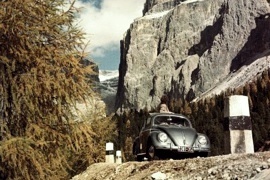 |
 |
|
| |
Also see: Volkswagen Car Reviews | The History of Volkswagen |
| |
The car that needs little introduction, Adolf Hitler's
dream of building a low-cost car for the masses has proved
to be a huge hit for decades and boasts over 21 million
sales. |
|
 |
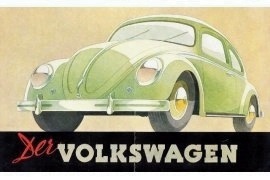 |
 |
|
| |
Also see: Volkswagen Car Reviews | The History of Volkswagen |
| |
It was in the 1930s when Ferdinand Porsche created the "people's car" - the Volkswagen. The Type 1 Volkswagen with its distinctive shape became known as the "Beetle" and became the most popular mass-mobility car of all time. The first VW Beetle arrived in New York in January of 1949. |
|
 |
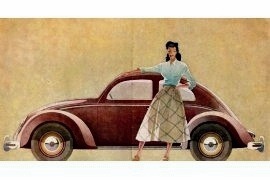 |
 |
|
| |
Also see: Volkswagen Car Reviews | The History of Volkswagen |
| |
The selling price of the 1949 Beetle was $800 and two were sold that year in the U.S. By 1960, Volkswagen had imported 500,000 Beetles into the U.S., and by 1981 the 20,000,000th Beetle was produced. The rear-engine, rear-wheel-drive car had excellent road-handling capabilities, especially in winter. The gasoline tank was mounted under the front hood. Early models did not have a gas gauge but did have a reserve tank that was activated by a lever in the passenger compartment. The Beetles were powered by a four cylinder 1.13 liter motor that delivered 18.6 kW (25 hp) at 3000 rpm. |
|
 |
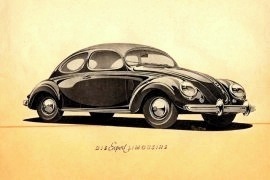 |
 |
|
| |
Also see: Volkswagen Car Reviews | The History of Volkswagen |
| |
The horizontal pistons had a bore of 75 mm (2.94 in) and a stroke of 64 mm (2.52 in) with a compression ratio of 5.8:1. The crankcase was a two-piece design with bolt-on finned cylinder heads. The centrally mounted camshaft was gear driven directly off the forged steel camshaft. The pushrods were housed in separate tubes connected to the aluminum alloy heads. The engine was air cooled by an upright fan connected by a shaft to the generator, that was belt driven. |
|
 |
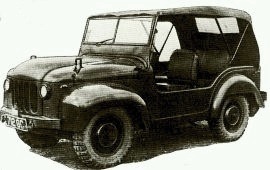 |
 |
Wolseley British Army FV1800 Series ¼-ton 4 x 4 Mudlark |
| |
Also see: Wolseley Car Reviews | Wolseley Production Numbers 1940 - 1950 |
| |
Wolseley produced a small number of pilot models of the new British Army FV1800 Series ¼-ton 4 x 4 vehicle, which was developed from the Nuffield 'Gutty' and powered by a Rolls-Royce B40 petrol engine. In one British Military publication the vehicle was listed as 'FV1801 Wolseley B. Jeep' ; it was also known as Wolseley GP Vehicle, 5-cwt. 4 x 4. The Austin-built Champ, which was the eventual quantity-production model differed mainly in having restyled wings and stiffening ribs pressed in the bonnet and body side panels.
|
|
 |
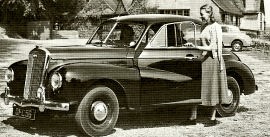 |
 |
Wolseley Four-Fifty and Six-Eighty |
| |
Also see: Wolseley Car Reviews | Wolseley Production Numbers 1940 - 1950 |
| |
The Wolseley 1949 programme consisted of two four-door Saloons, the Four-Fifty and the slightly longer Six-Eighty. They shared the bodywork and many other components with the Morris Oxford and Six, but had their own distinctive radiator grilles with the traditional illuminated radiator badge. The engines were similar in design, differing only in the number of cylinders and carburetors (Four-Fifty; single-carb. 51-bhp 1476-cc Four; Six-Eighty; twin-carb 72-bhp 2215cc Six) Bore and stroke were the same, 73·5 x 87 mm; both engines had an overhead camshaft. Prices were £704 and £767, wheelbase 8 ft 6 in and 9 ft 2 in respectively.
|
|
 |
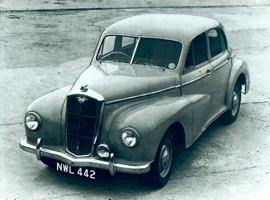 |
|
 |
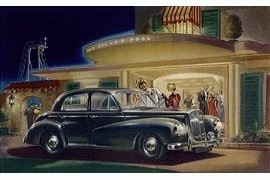 |
 |
Wolseley 4/50 |
| |
Also see: Wolseley Car Reviews | Wolseley Production Numbers 1940 - 1950 |
| |
Quoting the brochure: "The first glimpse of the Wolseley Four-Fifty gives an impression of a car of unusual grace and style. Designed and built with meticulous care, no detail affecting the comfort and safety of driver and passengers has been overlooked. The 1.5 liter four-cylinder overhead valve engine, with valves operated direct from the camshaft, develops 50 brake horse power. It will cruise happily at 60 m.p.h. and exceed 70 m.p.h. Long torsion bars and telescopic shock absorbers ensure smooth travel, free from roll. Sparkling new colors are founded on a strong "Monoconstruction" body, rust proofed throughout for long life and lasting beauty. All upholstery is in leather with Dunlopillo foam rubber cushioning. An air circulating and heating unit is standard. Hydraulic brakes are of the latest type Lockheed with two leading shoes at the front; safety glass is fitted to all windows. The Wolseley Four-Fifty is a full five-seater car."
|
|
 |
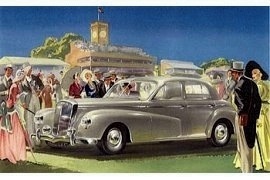 |
 |
|
| |
Also see: Wolseley Car Reviews | Wolseley Production Numbers 1940 - 1950 |
| |
Quoting the brochure: "The Wolseley Six-Eighty is designed for the motorist requiring luxury combined with a high standard of performance. It is powered by a 2.5 liter o.h.v. six-cylinder engine, overhead camshaft engine, developing between 70 and 80 b.h.p. Wire wound, controlled expansion aluminum pistons ensure even compression and maximum output at any engine temperature; a wonderfully smooth flow of power is delivered throughout the speed range. Twin S.U. carburetors are fitted for high efficiency performance. Large diameter Lockheed hydraulic brakes, smoothly positive in action, give perfect confidence at the high speeds attainable with this car. All upholstery is in fine quality English leather. A car heater with in-built de-mister and heater ducts is a standard fitting and provision is made for the installation of radio. The polished wood facia panel is a new design. The Wolseley Six-Eighty is a long wheelbased car -110 in.- combining the fine features of the Four-Fifty with unusual luxury and superlative performance. It is a car which will delight the most critical of motorists."
|
|
 |
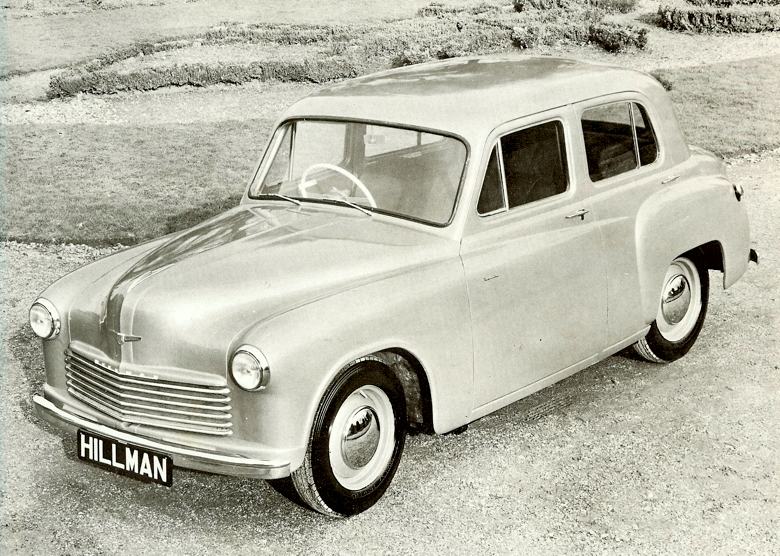 1949 Hillman Minx Phase III Saloon.
1949 Hillman Minx Phase III Saloon. |
|

|
|
 |
|
|
|
